A TOYHEM tour of the Swingin’ Sixties!

—
Welcome to TOYHEM! For the sixth straight holiday season, we’re bringing you a series of features and columns celebrating the toys of our youth, which often made for the best memories this time of year. Click here to check out the complete index of stories — and have a Merry Christmas, a Happy Chanukah and Happy Holidays! — Dan
—
UPDATED 12/3/24: This groovy column by Paul Kupperberg first ran in 2020 but it was so popular, we’re reprinting it this year. Dig it. — Dan
—
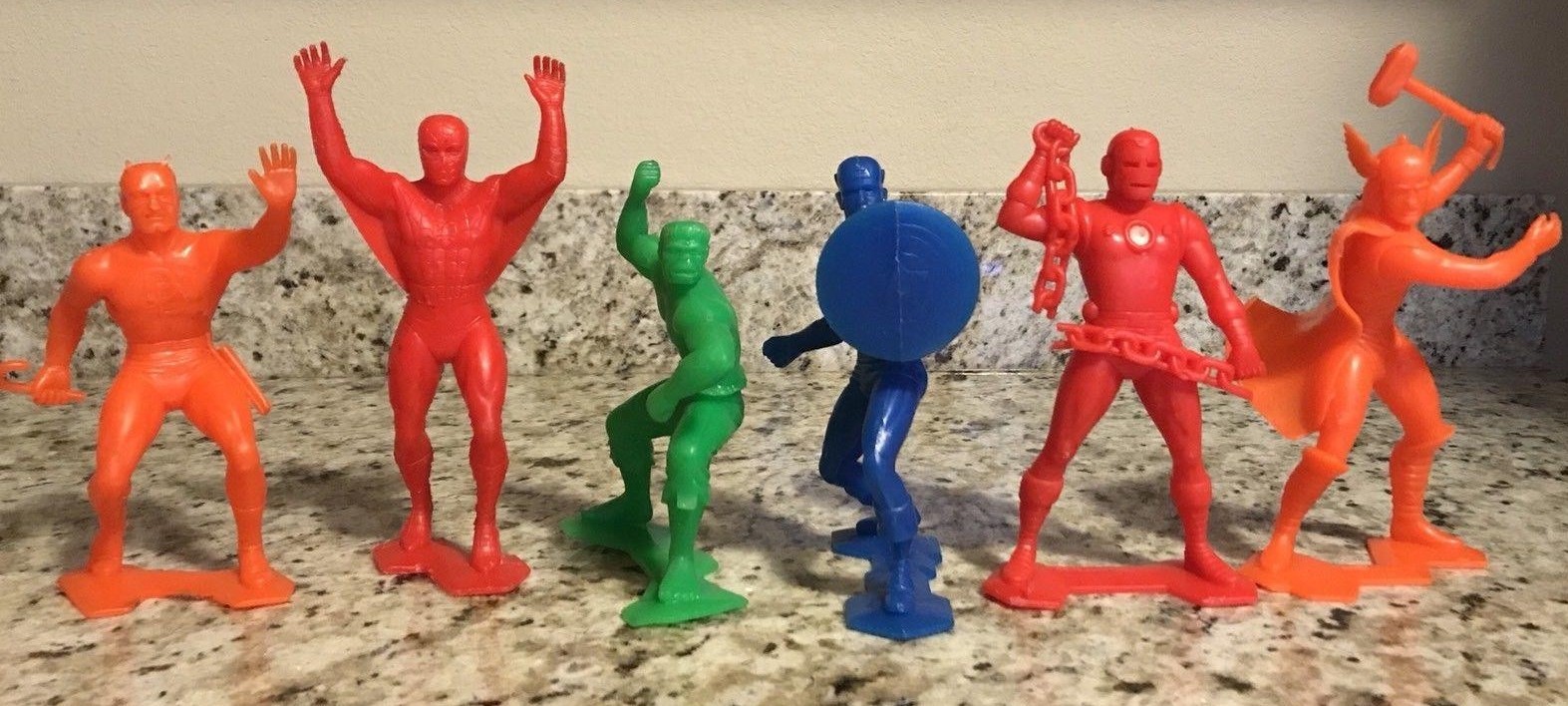
By PAUL KUPPERBERG
We live in a golden age of comic book toys and tchotchkes. Action figures. Statues. Props. Accessories. Clothing. Jewelry. Home decor. Name it. But this wasn’t always the case. Even the explosive success of the 1966 Batman TV show gave way to a relatively small increase in such product. Still, a minor increase is better than nothing, but the appearance of a really great toy (singular, as opposed to entire toy lines like the later G.I. Joe or Masters of the Universe, et al) was a significant event.
While I desired deeply, and for a variety of reasons, all of the following, I didn’t actually own all of them. Toys were expensive. And, hey, what were we? Made of money?! (Sorry. Childhood flashback there!)
Thanks to Batman, 1966 seems to have been the pinnacle of toy activity for the decade, and I, the budding 11-year-old comic book reader and fan, was perfectly positioned to take in this sudden explosion of comics (and comic book-like) related toys and games.
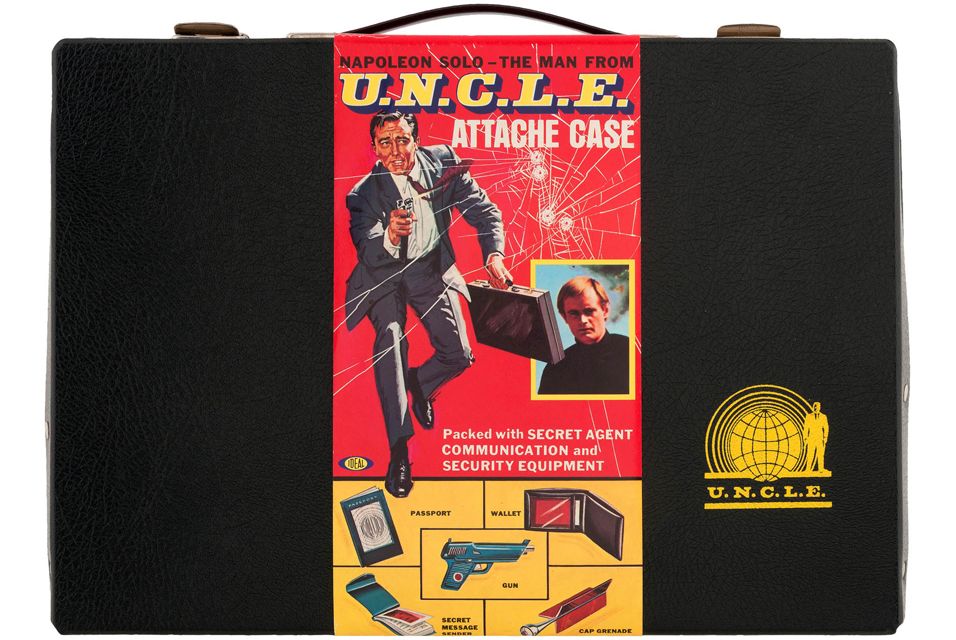
—
13. Aurora Super-Hero Model Kits (Aurora Plastic Corporation, 1960s). I was never much of a model builder. I didn’t have the patience or manual dexterity to do a very good job of it and I was always disappointed by my lopsided, over-glued results. I’d given up even trying after a few airplane and car models, but then those crafty bastards at Aurora Models started issuing a line of licensed DC and Marvel Comics plastic model kits: Superman, Superboy (and Krypto), Batman, Spider-Man, Hulk, Captain America and others, priced at 98 cents to $1.49 (“each wherever toys and hobby products are sold”).
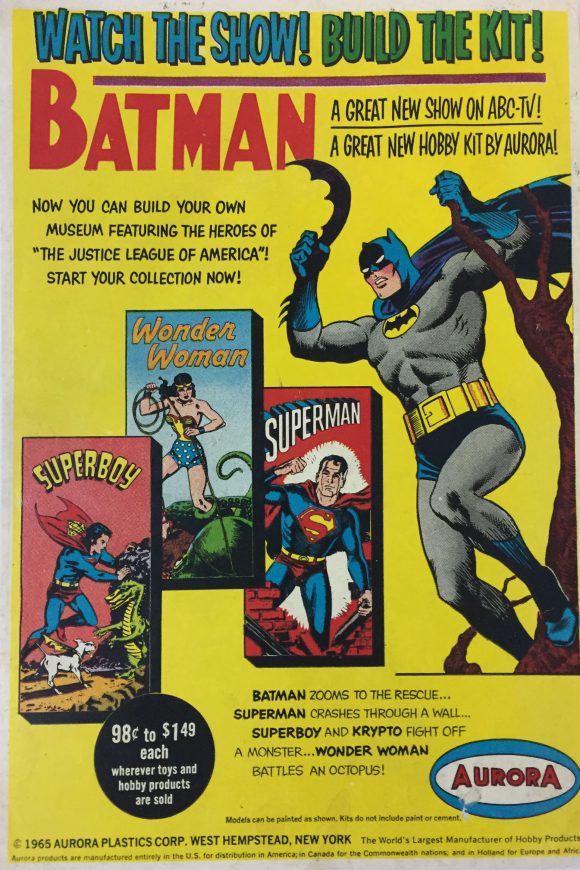
Most photos from various internet sources
A buck was a lot of money to a kid in the 1960s — enough to buy six or eight comics depending on the year/cover price — equal to about $8.50 in today’s dollars… or about two comic books. But the DC models were in my face, in every toy store, advertised in the comics, using art by Curt Swan, Carmine Infantino and Murphy Anderson. I finally broke down on a visit to the stationery store on Utica Avenue between Church Avenue and Linden Boulevard and bought the Superman kit, a tube of airplane glue, and three little jars of model paint: red, blue, and yellow.
If I could have found a place to dig in my concreted and paved over East Flatbush, Brooklyn, neighborhood, I would have buried the result. But that didn’t stop me from going back and, one by one, picking up the others and trying to build them. My experience with the Superman model did teach me to hold off buying the paint until I saw the results of my handiwork. I never had to buy another color.
—
12. Batmobile C267 Diecast Car (Corgi Toys, 1966). Mettoy Playcraft Ltd. of England’s Corgi cars were like Mattel’s Hot Wheels, only cooler. And cooler still… Batman! A 1/43-scale replica of the George Barris design for the Batman 1966 TV show, this sleek black beauty with red interior taunted me from display cases in any number of places where fine toys were sold for many months until I finally scraped up the allowance and birthday money to buy it.
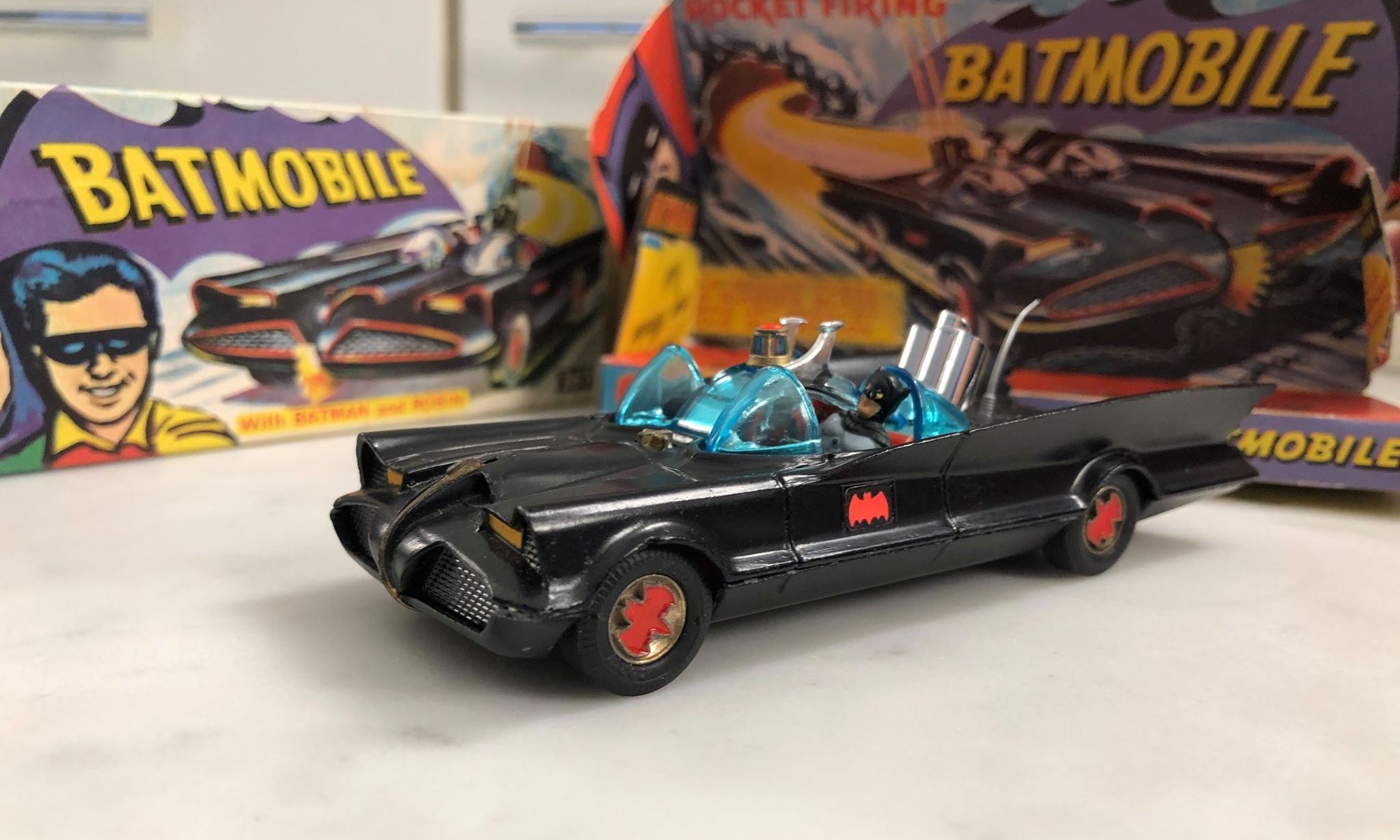
This Corgi Batmobile belongs to Dan Jurgens. Click here for his TOYHEM story!
In the speed of light world of fragmented internet fads and memes, it’s hard to explain the mid-1960s universal popularity of Batman (along with the other two pop culture fads of the decade, the Beatles and Bond, James Bond). And for a kid like me who had already become captivated by the four-color comic world of Batman, the “in living color” Batman on TV became an obsession. The Corgi Batmobile was the only toy car I ever lusted after in my young life.
—
11. Batman Pez Dispenser (1966). Far more affordable to us Bat-crazed kids was the yummy Batman Pez Dispenser. Pez candy was invented in Vienna in 1927 (“pez” is short for pfefferminz, German for peppermint) and was marketed to adults, sold in dispensers shaped like cigarette lighters; it wasn’t until 1955 that Pez was introduced in the U.S. market as a product for kids with dispensers in the shape of popular cartoon characters, beginning with the likes of Popeye, Mickey Mouse and Santa Claus.
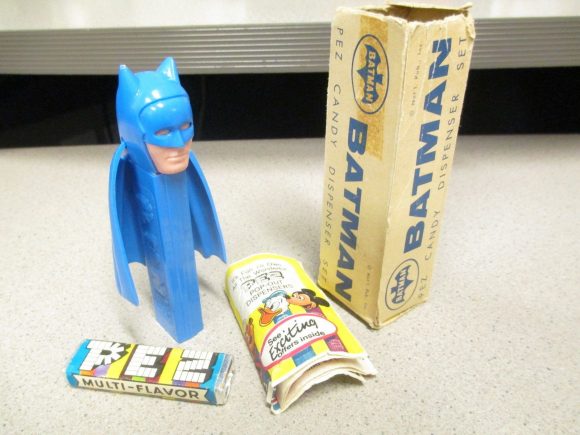
There have been different, probably even better sculpted editions of the Batman Pez Dispenser over the years, but that first pale blue one (without feet) with the attached cape was the best. I don’t remember what the dispensers (usually packaged with a couple or three packs of candies) cost at the time (29¢?), and I seem to recall that the cape was made of soft material instead of hard molded plastic, but I do vividly remember popping Pez candies (now sold in all sorts of flavors beyond peppermint) out of Batman’s throat to chew on while enthralled by the Caped Crusader’s adventures on the small screen. How sweet it was!
—
10. Ben Cooper Superman Halloween Costume. Even as a little kid, I never liked playing dress-up. I was too shy and self-conscious to want any attention drawn to myself (I’ve mostly gotten over it, but I still don’t do costumes), but that didn’t stop 9-year-old me from longing after the Superman costume sold by the legendary Ben Cooper Costume Company of my hometown, Brooklyn.
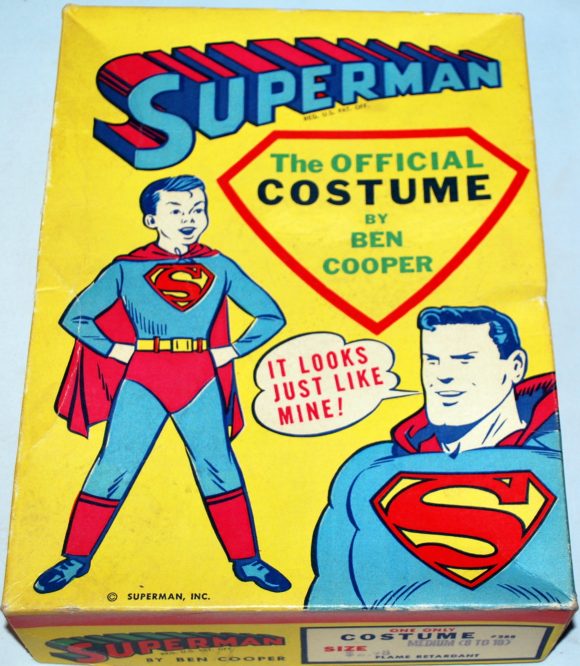
That version I recall had been around since the 1950s and was a pretty faithful reproduction of the Man of Steel’s blue, red, and yellow costume (minus footies) that you could wear over your street clothes, with a cape that tied around the neck. Soon, the company would start to stylize the costumes, changing things up (likely for ease of manufacturing), sometimes including character images on them, like they had to explain who these guys were.
Ben Cooper did a bunch of DC and Marvel costumes in the 1960s — they licensed Spider-Man hot off the newsstand in 1963 — but Superman was the only one I ever wanted to own. I never did.
—
9. Superman Colorforms Playset (1964). Nowadays, we call them “vinyl clings,” but in the 1960s, “Colorforms” was state-of-the-art for 2-D interactivity. No videogames existed in which we could manipulate our heroes through peril fraught landscapes; instead, we had little pieces of vinyl with the characters printed on them that we slapped onto a printed vinyl backdrop to which they stuck by static cling.
The Superman Colorforms playset was an immediate eye-magnet for me when I spotted it on the shelf of John’s Bargain Store on Church Avenue. The white box featured a full-on flying shot of Superman by Curt Swan (and George Klein?) and held the promise of my being able to create my own super-action-adventures for a mere 69 cents!
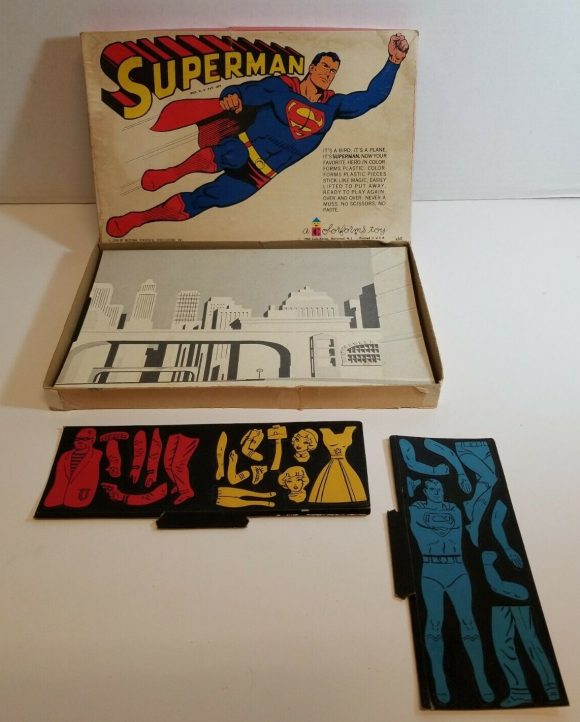
The set came with the “figures” of Superman (printed on flat blue vinyl), a generic comic book burglar (red), and young lady purse snatching victim (yellow). So that kids could manipulate and “pose” the figures, they each came in separate pieces, i.e., torsos, arms, legs, etc.
Superman came with two sets of arms and three sets of legs: standing, flying, and wearing Clark Kent’s trousers. It was a pretty clumsy and awkward system, but it was better than nothing. The first Superman videogame from Atari wouldn’t make it to market for another 15 years.
—
8. The Batman Board Game (Milton Bradley, 1966). Holy game pieces, Batman! I was never much of a board game player as a kid. My older brother, when he would play, bullied me and cheated and my younger one wasn’t interested in the same stuff I was. But the sight of the Dynamic Duo on the cover of this Milton Bradley game was all that was necessary to make it a grail toy.
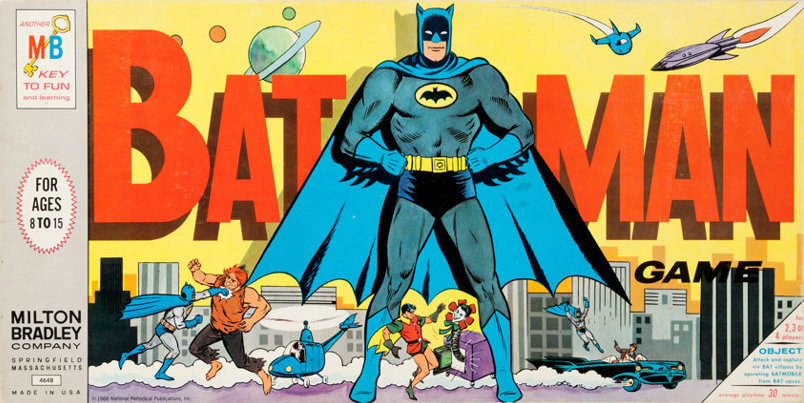
Milton Bradley was the Nintendo, Microsoft, and Sony of board games all rolled into one, and they were the largest game manufacturer in the country by the 1960s. Evergreens like Chutes and Ladders and Candyland were the bread and butter of the company (which has been owned by Hasbro since the 1980s), but MB was quick with a licensing deal and kept the shelves stocked with games based on the current pop-culture trends.
The Batman Game had, I remember, a lot of pieces. Part of the fun of cracking open a brand-new board game was the minor “some assembly required,” which consisted mostly of punching out little cardboard playing pieces and inserting them in plastic holders. The game itself involved Batman and Robin game pieces in pursuit of villains like the Penguin, Joker and Blockbuster through the streets of Gotham City printed on the board. It was way more complicated than it needed to be despite the box’s claim that this was a game for ages “8 to 15.”
—
7. Major Matt Mason in Space (Mattel, 1966). Batman, Bond, and the Beatles may have been the pop cultural touchstones of the 1960s, but it was the Space Race to the moon that was the socio-political glue of American culture… and it was televised! Even if I had been a sports fan (never was, never will be), NASA’s original seven Mercury astronauts would have left any baseball-hitting athlete in the dust of popularity.
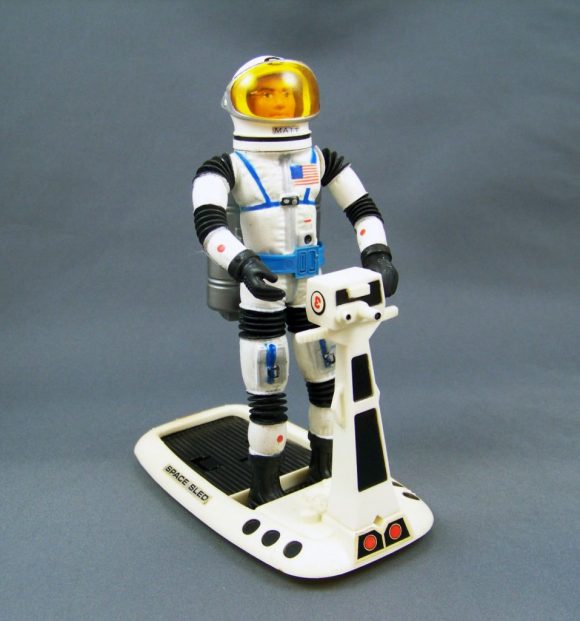
Click here for Mark Waid’s TOYHEM story on Matt Mason!
In 1963, the arrival of Hasbro’s G.I. Joe on the toy market had opened up the “doll” market for boys. The genius of Joe was the gun. Stick a weapon in the hands of a kid’s dolly and it goes from girly to macho in the blink of an eye. Joe was the followed in the 12-inch articulated “action figure” market by the Marx Company’s Johnny West (“It’s a fight to the finish, as you can see, between Johnny West and Chief Cherokee!”), and in 1966 came Mattel’s Major Matt Mason in Space.
Originally modeled after actual NASA equipment and gear, there were four separate six-inch bendy astronauts available (including an African American, Lt. Jeff Long), but the real stars of this toy line were the accessories, including all sorts of futuristic vehicles, moon bases, and ships. There were also a couple of 12-inch “giants” in the mix, including Captain Lazer, Callisto, and the battery-powered Scorpio.
—
6. Official Batman Utility Belt (Ideal, 1966). There was no way in hell I was ever going to get one of these. It was big, expensive, and had lots of loose plastic pieces that were just begging to be lost or broken, likely rendering it useless and discarded after only a few weeks. At least that was my parents’ take on it.
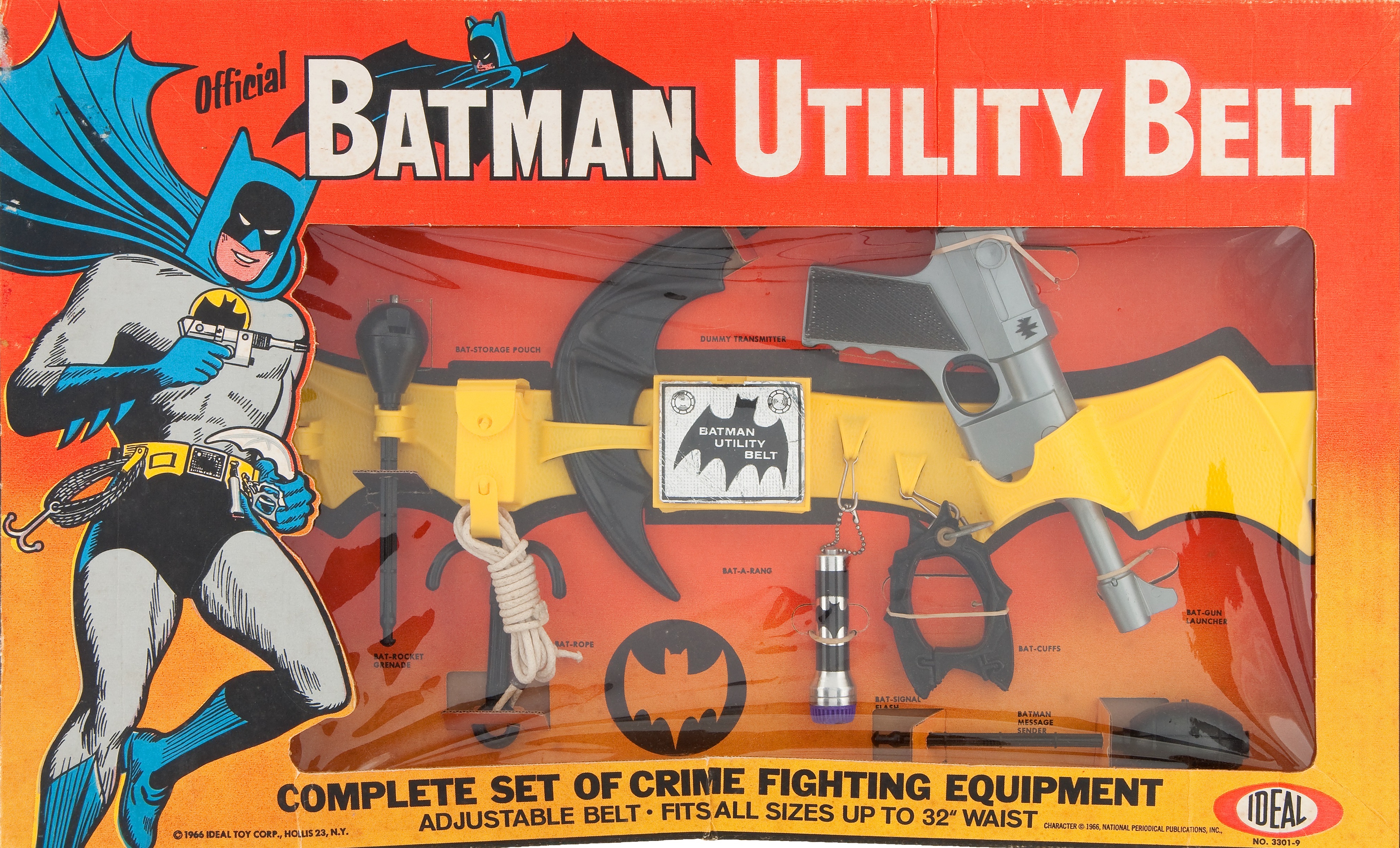
But it was so cool! At the base of it was a bright yellow belt, just like the one Adam West wore on TV, complete with what looked like pouches and a Bat-belt buckle. And to hang from the belt or hide in its compartments, a staggering array of Bat-weaponry: A Bat-Rocket-Grenade, a Bat-Storage Pouch with a coiled Bat-Rope and grappling hook, a Bat-A-Rang, a “Radio Buckle” storage compartment, a Bat-Signal Flashlight, Bat-Cuffs, Bat-Gun Launcher, and Message Sender.
I stared and stared at the Official Batman Utility Belt Crime Fighting Equipment Set on toy and department store shelves forever, but no amount of wishing, begging, or negotiation would ever make it mine. If they didn’t now sell for thousands of dollars, it’s one of the few childhood toys I’d be tempted to seek out and own today.
—
5. Marvel Comics Mini-Books (Marvel Comics, 1966). Back in the days when a penny could actually buy you something, there were 1-cent gumball machines all over the place, from subway platforms to supermarkets and candy and drug stores. Insert your penny (or nickel, depending on what was being dispensed), twist the chrome plated handle, and you got a piece of gum, candy, or a toy (little rubber balls, charms, troll figures, stickers, rub-on tattoos, etc.) dropped down the chute from the big glass dome into your sweaty little hands.

In 1966, Marvel Comics rolled out the Marvel Comics Mini-Books, a series of six postage-stamp-size minicomics featuring the secret origins of Spider-Man, Hulk, Thor, Captain America, Sgt. Fury and Millie the Model that were only sold via gumball machine, each one stuffed into its own individual clear plastic shell.
Of course, you had no control over which prize would drop from the dome, so even though there were only six titles, it probably took 10 or 12 nickels to accumulate a complete set. I don’t know who wrote or drew them (Marvel’s recent oversize boxed set reprint includes a new seventh book by historian Mark Evanier that I’m sure covers that ground), but I reread them over and over again until the glue holding their little spines together split. (Click here for an INSIDE LOOK at the set.)
—
4. Marvel Super Heroes (Marx, 1967). I first saw these advertised in the Marvel Comics of the time, a set of six small monochromatic plastic (in up to eight hues) “unbreakable 3-D statues” of Captain America, Thor, Iron Man, Hulk, Spider-Man and Daredevil, sold as two sets of three for $1.50 per set (plus 50¢ shipping). The Marvel house ad made these intriguing items a bit of a pig in a poke as they were represented by a single, comic book line drawing of the Thor statue.
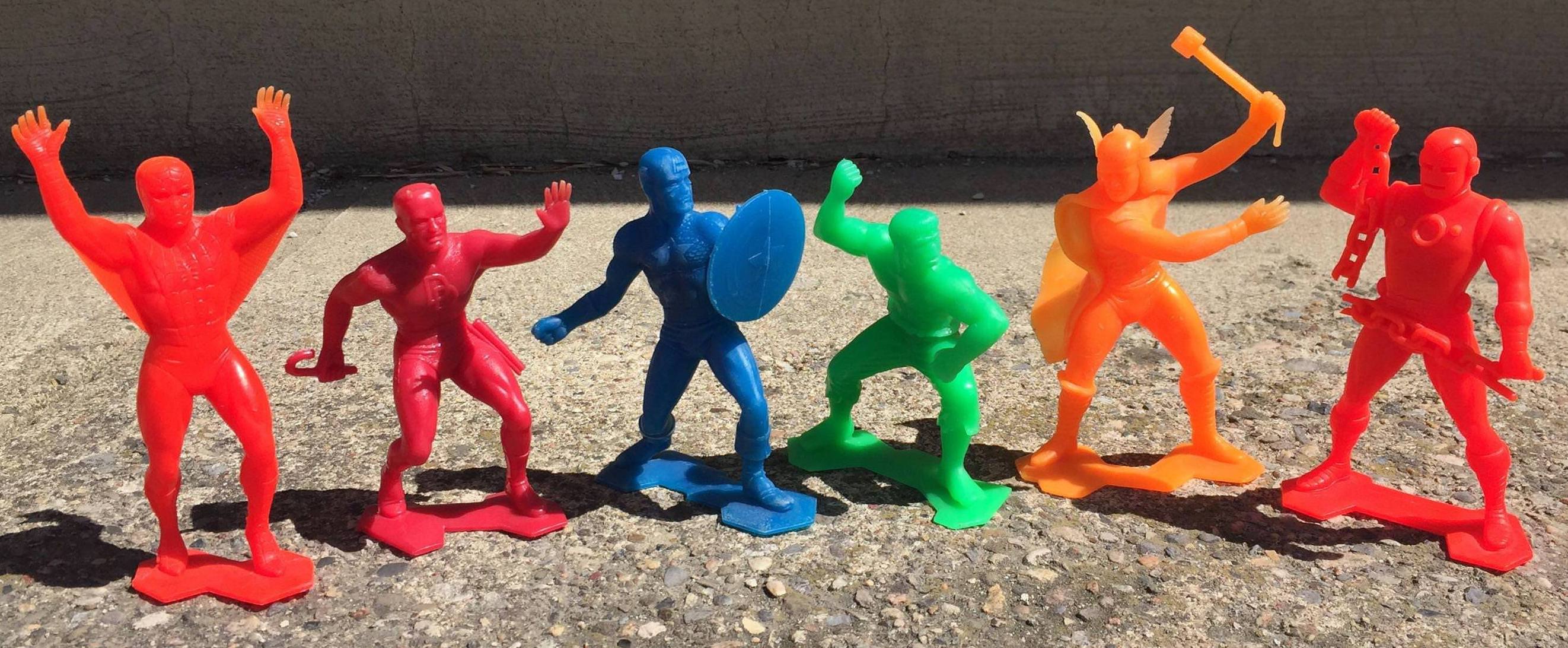
This was an offer from the short-lived Marvelmania fan club, and there was no way I could come up with $4 in one lump to be able to afford both sets, but much to my relief, the statues did eventually turn up in stores and were sold individually for 39 cents each (cheaper by 28-cents per statue than mail order when shipping was factored in!).
One by one, I accumulated all six of the Marx Marvel Super Heroes statues, lining them neatly side-by-side on my little cabinet bookshelf in the bedroom I shared with my two brothers. These weren’t toys I played with; for starters, they didn’t do anything except stand there in dramatic poses. They were probably the first things I ever bought – aside from the comics themselves – that I understood as “collectibles,” things to own for the sake of owning and showing them off.
—
3. Captain Action (Ideal, 1966). As far as I’m concerned, Captain Action is the greatest concept for an action figure. Ever! And that includes my beloved G.I. Joe (not so coincidentally created and designed by the same man, Stan Weston).
Captain Action was Ideal’s answer to Hasbro’s Joe. On the face of it, they were both 12-inch, articulated action figures used as the base toy to sell the wads of costumes and accessories available. In Joe’s case, it was mostly generic military gear. With Captain Action, it was about the costumes.
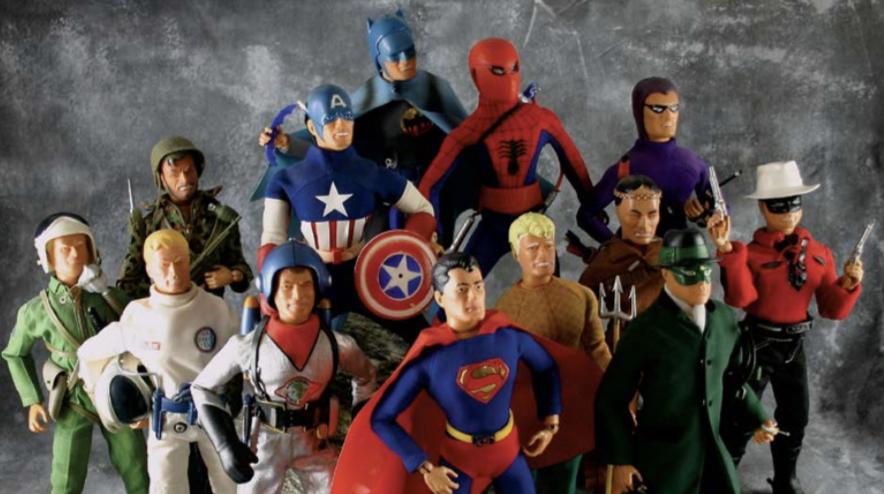
Photo by Craig Hedges, via TwoMorrows’ RetroFan #7. Click here for Michael Eury’s TOYHEM story!
Superhero costumes! Ideal had worked out licensing deals with DC, Marvel, newspaper syndicates, and other I.P. holders to sell separate costumes and accessories that enabled the black-and-blue costumed Action to dress up and become Superman, Batman, Aquaman, the Lone Ranger, Tonto, the Phantom, Flash Gordon, Captain America, Spider-Man, Sgt. Fury, Steve Canyon and the Green Hornet. The Captain Action section of the toy store display could have almost passed for a newsstand rack!
Captain Action lasted only two years, its existence cut short I imagine by the complexity of all the licensing deals, and I never did own an actual Cap figure of my own. But I did have two G.I. Joes and, while Joe was a little bulkier than Action, the superhero costumes and masks still more or less fit him. I eventually managed to scrape up the dough for the Superman and Captain America costumes, both of which I played with until they started to disintegrate.
—
2. The Man from U.N.C.L.E. Attaché Case (Ideal, 1965). Remember the Batman utility belt from a few entries back? Meet its cooler, older brother, the amazing Man from U.N.C.L.E. Attaché Case.
Another one of those too-expensive/too-many-pieces toys parents hated, this was a kid sized (10.5 x 15 x 2.4”) black texture vinyl briefcase stamped with the U.N.C.L.E. logo and filled with gadgets and booby-traps just like the kind carried around by our favorite TV and movie spies.
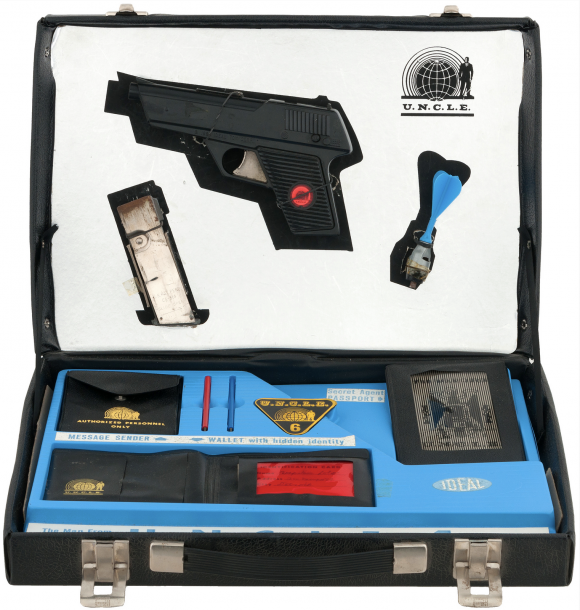
The case came “packed with secret agent communication and security equipment,” including a wallet with I.D. cards and a passport, a plastic gun with a metal clip that held plastic bullets, a cap-firing grenade, the pen-shaped U.N.C.L.E. radios, and a plastic vacuform insert to store all the components. It was the only time I ever thought a dumb old briefcase could be cool.
—
1. G.I. Joe (Hasbro, 1964). But in the end, there can be only one.
And he is Joe!
There was nothing in the world that 9-year-old me wanted more than a G.I. Joe. From the moment I first saw a commercial for the classic 12-inch articulated figure in the summer of 1964 until my hands closed around one that Chanukah, it was all I could think about. But it came with a heavy price: I had to get along with my abusive older brother with whom I’d also have to share this precious gift ($3.50 retail in 1964 was big bucks).

Joe suffered the loss of his right hand straight out of the box due to the tussle to claim ownership, and Alan immediately lost interest in the broken toy. Broken or not, Joe was mine. All mine. (I wrote about the experience in my buddy Jim Beard’s 2018 anthology, The Joy of Joe.) That G.I. Joe and a second figure I traded some other stuff for from a friend, became my constant companions and playthings for several years that followed.
Unable to afford many of the cooler playsets and accessories, I first tried shoplifting (I didn’t have the nerve for it; I never opened the package and, after a week of feeling sick to my stomach with guilt, I secretly slipped it back onto the rack in the store I’d taken it from), then making my own. Crude as they were, it was amazing what I could build out of construction paper, cardboard, old shoe boxes, Quaker Oaks containers, and plastic parfait cups from Carvel ice cream.
—
MORE
— The Complete TOYHEM Index of Features and Columns. Click here.
— Another 13 CLASSIC TOYS We’d Like to See Re-Released — RANKED. Click here.
—
PAUL KUPPERBERG was a Silver Age fan who grew up to become a Bronze Age comic book creator, writer of Superman, the Doom Patrol, and Green Lantern, creator of Arion Lord of Atlantis, Checkmate, and Takion, and slayer of Aquababy, Archie, and Vigilante. He is the Harvey and Eisner Award nominated writer of Archie Comics’ Life with Archie, and his YA novel Kevin was nominated for a GLAAD media award and won a Scribe Award from the IAMTW. He also wrote an essay for DC’s Aquaman: 80 Years of the King of the Seven Seas. Check out his new memoir, Panel by Panel: My Comic Book Life.
Website: https://www.paulkupperberg.net/
Shop: https://www.paulkupperberg.net/shop-1
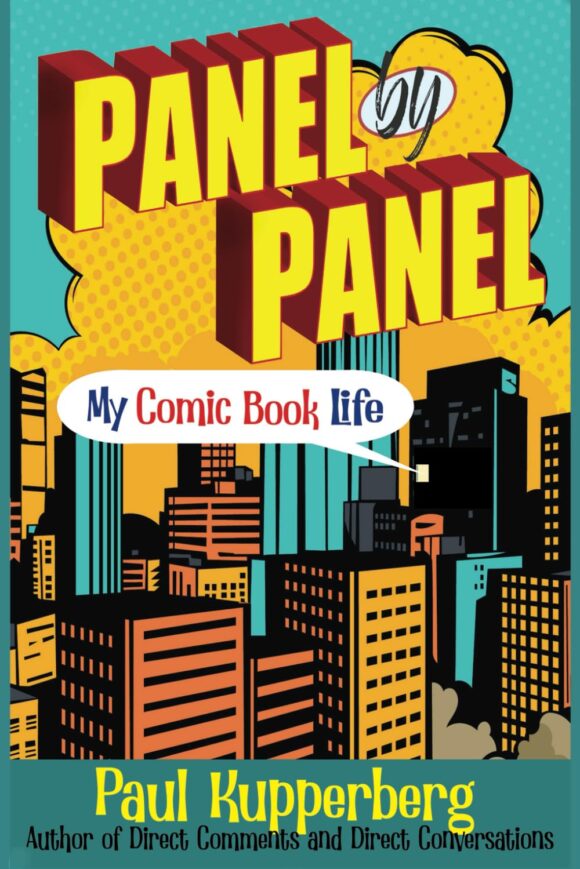

December 23, 2020
I had most of the listed toys except for GI Joe and the Man from UNCLE stuff. The only difference is that I had the Batman versions of the Colorforms kit and the Ben Cooper costume. Captain Action was and still is my favourite. I’m so glad I was a kid in the 60s.
December 23, 2020
Mr. Kupperberg definitely nails it here. 🙂
December 23, 2020
I am around your age, Paul, and had one of the first GI Joes also–my parents also got me the rifle / bayonet to go with it, as well as the foot locker (which I put my name on the top of). I was anxious to fill it with the various weapons and such (as it came with a guide that showed what went where), but the toy stores around always seemed to have the same few items for sale, and never did so. When I outgrew playing with GI Joe, my sister inherited Joe as well as the foot locker, which she used for her Barbie stuff (she also thought Barbie was the perfect girl for Joe).
Also remember having (at least) the Hulk Mini-Book, which I had purchased from a gumball machine. I remember taking it with me to church the next morning, and puzzling over what a “98 pound weakling” was as we were driving to service (I was only 60 lbs at the time, and thought 98 lbs was massive!).
Didn’t have any of the U.N.C.L.E. stuff, but did have a 007 Lightbox that came with sheets of Bond in action to trace over. Just a simple thing in plastic with a light bulb underneath, and the 007 logo at the top of the box where pencils and pens could be stored. Used it for many years for school projects and such (where we had to trace maps of countries)–I still have it in my basement, where it sits unused to this day.
Do you remember Sixfinger, the spy toy from Topper? I had one of those and used it for my spyplay.
December 23, 2020
Just found an image of 007 Tracing Set: https://cultbox.co.uk/features/lists/the-weirdest-and-worst-james-bond-merchandise-of-all-time/2
And Sixfinger: https://www.youtube.com/watch?app=desktop&v=ElVzs0lEULs
December 24, 2020
When I was a kid, I liked the comic book style inserts that came with Colorforms. By the time I got to the company, the inserts had been reduced to a slip of paper. I was able to revise the comic format for a Winnie the Pooh Play Set.
Also interesting is that a Matt Mason is featured here along with Colorforms. Matt Mason was the “inspiration” for the Outer Space Men by Colorforms which is arguably one of the most sought after toys in the galaxy!
December 24, 2020
I am drooling over the Man from UNCLE attaché case! When I was young I had the Napoleon Solo gun set and was very adept at assembling it in seconds. Too bad — a mint set of that gun goes for around $2,000 now. I never knew this attaché was around back in the mid sixties
December 27, 2020
When I was a kid, (not sure how old, maybe 7 or 8?) a classmate of mine had this Batman flashlight. The TV show was the rage at the time, and I really wanted one. I asked my folks a few times, and my mom said she was going out to buy one for me one day. When she got home though, she said she’d stopped off to visit a friend of hers who had a son that was intellectually handicapped. She showed the torch to them, and ended up giving it to him, as she said it didn’t work that well. What could I do? I was kind of upset but I couldn’t really kick up a fuss about it. I managed to find a photo of it online –
https://imgs.inkfrog.com/pix/angfrog/batman.jpg
I still kinda wish I’d gotten it though.
December 27, 2020
ps, I also wanted a Six Million Dollar Man action figure one year, but it must have been too expensive, as my parents got me a Big Jim instead….
December 2, 2021
My Dad’s annual workplace Christmas party was a family affair, and Santa had age-specific toys for every employee’s child. For years my younger brother and I got the same item, but at age 6 or 7 I “graduated” to the big kids’ group and scored the best gift ever: A Man From U.N.C.L.E. Counterspy Kit. It came with a lame cardboard briefcase but more than made up for it with other contents: in addition to all the goodies in the standalone briefcase set, it included add-ons to the U.N.C.L.E. gun (silencer, extended stock, “secret message” darts), a knife with a single-shot “gun” in the handle (both fired spring-loaded plastic “bullets”), an “exploding” cigarette case and flat, slimline shrapnel grenade (both powered by paper caps); disguise kit, message coder/decoder, and a plastic trenchcoat with hidden pockets to hold all the gear.
My brother was so (understandably) envious that Dad pulled some strings and brought home a second kit for him the week after the party. Our family room was a crossfire for weeks. 🙂
December 2, 2021
I don’t want to be “that guy” but a couple of times in this article GI Joe is credited as “Mattel’s G.I. Joe”. Of course, Hasbro made GI Joe. I suspect Paul just had a typo here or there or got them conflated when writing this, but since it’s been reposted this year, maybe that could be fixed?
Fun read as always!
December 3, 2021
Fixed! Thanks!
December 6, 2021
GI Joe was great. and the Corgi Batmobile and Aston Martin. Captain Action wasn’t carried by local stores, but I recall seeing one in a big chain and was mesmerized with the Superhero costumes – what a concept. Got on later on. The 60’s, that was the time to be a kid – the Christmas catalogs from Sears and others – man – if someone ever creates a time machine…. And don’t forget Hot Wheels – they had a comic book too!
December 13, 2022
My G.I. Joe and Space Capsule was my favorite childhood toy. My parents did not have a lot of money, so I did not get a lot of expensive toys. But, the Space Capsule was special – I kept it for years. A few years ago, I bought one of the remakes and have it displayed in my home office.
December 14, 2022
I love the Aurora kits. My dad had them as a kid (Batman, Robin, Superman, and Superboy) and kept them in really nice condition. I remember when I was a kid, he had to fix them up (strip them of old paint, repair anything that needed it and apply new paint), and I was happy to “help.” They are still sitting proudly in his home office.
December 3, 2024
I had the U.N.C.L.E. attaché case, the Superman costume, the colorforms playset and (not pictured) a Batman helmet from Ideal. Loved all of them – the brief case also had a gun holder and a trigger in the case handle that allowed you to shoot the gun while it was concealed within the case. Really thought these toys were awesome.
December 3, 2024
I didn’t have the UNCLE case but I did have the Secret Sam one. It shot fake bullets from inside the case and had a camera inside that would also work without the case being opened.
December 3, 2024
Oh, man, looking closer at one from eBay, maybe it was the Secret Sam case I had, after all (didn’t know about this one until you mentioned it). Hard to recall, as i was only 3-4 when I got it.
December 4, 2024
I followed everything about the Space Race and I got the Major Matt Mason doll (uh, “action figure”) and had it on my shelf for years in front of a 3-D postcard of a Lunar Landscape. Never had the accessories, but check out the old “Dark Shadows” TV show: In the scenes in David Collins’ room you can see the Matt Mason Moonbase clearly! (Must’ve been a tie-in!) And I got the Colorforms Batman when it came out—hadn’t thought of that in years! Thanks for the memories!